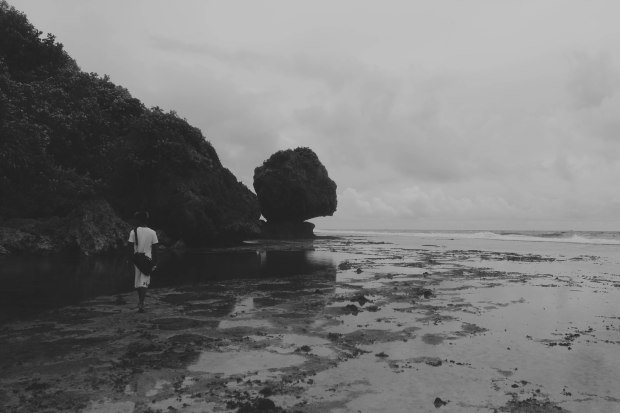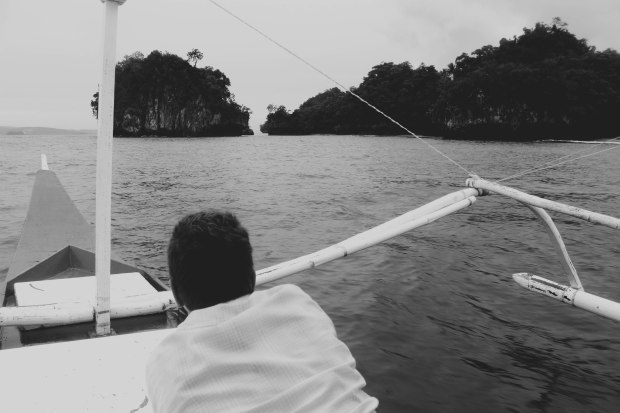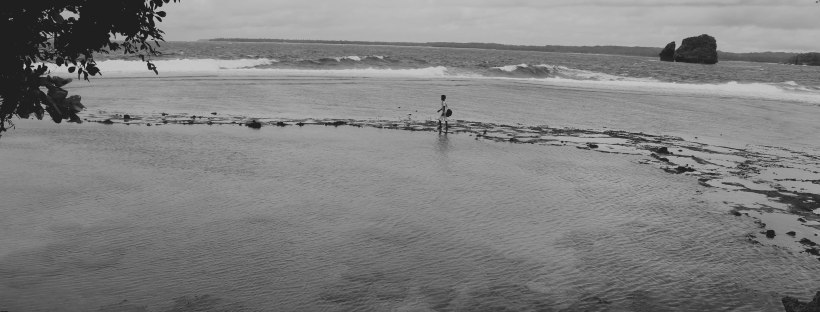A place doesn’t necessarily belong to who loved it first, I once wrote in a now-lost journal, but who loved it most. Then, it was written with such surety, short scribbles on a nondescript shore. But tides, it turns out, have a tendency to befuddle even the surest of sentiments. I often wonder constantly, who does a place really belong to?
Does it belong to the local who with such intimacy, knows the story attached to every scar? The secrets she hides behind her back? Or the discolorations she tries to cover with make-up?
But prone to over familiarity, will he notice the new dress she wore? The just-appeared mole at her nape? Too close at hand, too stranded on the everyday, will he be underrate her charm, the slant of her smile?
Or does the place belong perhaps to those who, with the eyes of novelty, is infatuated with everything at first glance, including her scars? Will the outsider see the place as the sum of her past, yet find the same past ignorable even when it shouldn’t be? Constantly enamored in fiction, will he run at the sight of her reality?
The air holds the tendrils of a storm in Cloud 9. A companion and I walk through mud-splattered potholes going back to the main part of General Luna. It would be a 30-minute stumble through darkness. Habal-habals become a friendly apparition but they are just that, an apparition. Now close to complete blackness, the companion and I take the first chance ride out.
The ride just happens to be Mickey’s, or as he corrects only the day after, Nikki’s. All blond highlights of him.
“Asa lami mokaon diri, kuya?”, I ask in universal address to drivers, whatever the age. He replies in a mumble that combined with the roar of the motor, is tantamount to no answer at all.
He drives off to GL’s Boulevard where Lalay’s, an unassuming dilapidated carenderia, sits overlooking the sea. Blondes and brunettes drink in monoblock chairs with a plan, it seems, to karaoke the night away. It was the type of hole compelling only to foreigners. Tourist trap, so I thought. Afraid to hurt his feelings, we watch Nikki disappear around the corner before sauntering off somewhere else.

“Doesn’t that rock formation look like a head?” asks Nikki.
Magpupungko’s Beach and Tidal Pool
“Hangin kaayo.”, Nikki warns at dawn the next day, his way of telling two girls with the thinnest of shirts to wear a jacket. In early light, Nikki becomes a creature of gestures. Pointing. Moving his head. Words were scarce, and few in between.
To Magpupungko, a 2 to 3 hour ride from General Luna, we take the faster and potentially more dangerous route. In Pilar, roads are slippery, and most are rutted by construction. At times, Nikki tells us to go down, two bodies impediments to balance. He guides the motorcycle to the other side, then gestures for us to sit again.
There are pechay plantations, watermelon fields and a collection of ornamental plants on the roadside. And we ask Blondie stops every few meters for the trigger happy to take enough shots. They are always never enough.
“Adto na ta na”, he prods, desensitized to these sights.
But ironically, for two outsiders, the best way to see Siargao is by habal-habal. All types of sensation– sun, wind, dust, smells, hoots of construction workers – is taken in a state of lightheartedness only an open vehicle can provide. Nikki, an easy favorite, happens to be the cheapest one.
“Ayaw ingna ang oban pila akong gi.presyo ninyo, ha. Secret jud.” he tells us after haggling to the last hundred.
Nikki has been to Magpupungko far too many times, he is underwhelmed. From shore to tidal pool, he jumps through different levels of rocks effortlessly whereas we wade in feeble steps, partly from caution, and partly because at times, Siargao holds too much beauty than it knows what to do with.
To a visitor, there is no distinction where Magpupungko, the tidal pool, ends and the sea begins. But Nikki who knows its diameter by memory, easily circles around it.
Magpupungko, it is called, because “pwede man ka mag-pungkopungko”. And alone on the shore, except for two spear fishermen waiting for their catch, he tells me how life is as driver, as surfer, as son, as Siargaonon.

Closeby rock formations at Magpupungko.
“Ngano di man ko mo.join ug surfing competitions?”, I ask him.
“Ai, di ko sure makadaog ko. Sa kadaghang maayo.”
He says all these in caution, used to too many tourists perhaps using a local’s life for small talk. He is, like how he describes this place, a cove here, a rock there, almost trying to overwhelm.
On the other part of the cove, Nikki points to a formation that from the side looks like a Caucasian head. “Naa may angol ana nga nindot tanawon. Ako beh.”, he says, telling me to pose, while Nikki experiments with the camera. Magpupungko, like the rest of Siargao, is gifted with waves. And with the sudden drizzle, we sit under the same rock formation and wait for the rain to pass, words, with him, always dispensable.
“Adto na ta na.” , he says, gauging the water’s depth. The waves were now closer and closer to each other, or so he says. Looking at the breaks, nothing seems to have changed.
But who’s to argue with a local? These are sensibilities only an insider will have.

Boats going to Sohoton and the Tres Marias.
From Sohoton to Tres Marias
There is a twilight zone of sorts in travel, a three dimensional land that allows individuals to converge in a state of convulsion. One in foreignness, the displaced gravitate towards each other triggered by the most trivial of catalysts.
This is how I found myself spoon-fed by a stranger who assertively tells me to “Taste my cooking. It’s delicious.” Cris, as he will later introduce himself, walks into the pizza place where we were already sitting after taking a beating from Nikki’s backseat. Choosing nothing from the menu, Cris breezes into the restaurant’s kitchen uninvited, pinching salt, slicing garlic for his “specialty”, Aglia Olio. The owner didn’t seem to mind.
In this twilight zone, there are no divisions. Tables start to merge and confessions are made outright. “My market value increases here.”, this German boldly points out after he fires countless questions, this time I playing the role as local. Somehow, we find ourselves inviting a stranger for a Bucas Grande daytrip, where a lagoon with non-sting jellyfish waited.
“Duol nalang, Noy?”, we asked every 5 minutes or so the day after, waves constantly battling the boat’s rudder.
“Duol nalang jud, Ma’am.”, the boatman responds. By this time, of course, we have already passed an island or two. In these parts, distance is measured in islands, never in miles. By the time we get to Sohoton though, travel time is forgotten. Cris and another German friend goes to the helm for the first look of transparent waters with a reachable coral life and rock formations intimidating in their magnanimity.

Felix, my guide to the cove.
“Beautiful, isn’t it?”, I find myself asking for affirmation however numerous the Wows were in between. Siargao is a landscape surreal enough that it almost feels like jumping inside a painting, or a tourist brochure. Yes, Cris affirms, definitely beautiful.
Bucas Grande is a playground for outdoorsmen. With sites in such close proximity to each other, we find ourselves victims to sensation overload. One minute there is a closed cove where murky spotted jellyfish, some 7,000,000 of them according to my guide, swim slantingly. The next minute, there are underwater caves, horseshoe rock formations and 8-feet drops vertical drops straight to deep waters.
“Ang kanang naay colored na korona, Mam, mao nay laki. Kanang plain brown lang, mao nay bayi.”, says the paddleboat guide, who points out that apart from the jellyfish, there are also tarsiers, macaws and pitcher plants here.

Cris getting a better view of the Siargao islets.
Adding to the sensation overload is an actual foreign body who often starts his sentence with “Back in Germany, we…” or “You know, what we did it in Germany was…” as he follows around with his camera. In my mind, Germany and Siargao have somehow merged, and like looking at the another surreal painting, I find myself unable to pinpoint which to concentrate on. Is it the foreign land demanding time and attention that, to learn from Nikki, can only be justified by silence? Or is it the foreign body who demands the same time and attention that conversations with him should somehow occupy a different space in the brain?
By the time we get to Diving Cave, another overwhelming sensation, where the exit-point leads to an 8-foot jump back to open waters, I have stopped forcefully taking inventory of places and names. I have stopped taking pictures. To cope is to let the stimulus handle itself. I have resolved to let the foreign land and body overwhelm me, and perhaps have been made better for it. There are three more islands we stopped on and several more beaches after but they somehow escape me now.
At day’s end, at another beachfront, amongst the many in Siargao, Cris tells me, “You know, I used to be so sure what was supposed to do, where I’d go, where I’d settle. I work in Finance for chrissakes, with calculated risk. But now, I’m not so sure.” To echo his sentiment is to somehow be redundant. The whole trip has been a tug of uncertainty. To be underwhelmed or overwhelmed. To be an insider or outsider.
In the evening, the boat docks back to General Luna with tired and hungry passengers that island hopped the whole day without nourishment. Where to eat, I asked them. Cris points to a small, dimly lit place across the Boulevard: Lalay’s. It must’ve been the hunger but everything – the tinola, chicken barbecue, rice – was delicious. Nikki, I can imagine, must be smiling.
We wave goodbye to the foreign bodies and the day after, goodbye to the foreign land.
A place doesn’t necessarily belong to who loved it first, I once wrote in a now-lost journal, but who loved it most. I don’t know if this is true anymore. But perhaps I’ve been made all the better, because I don’t.






